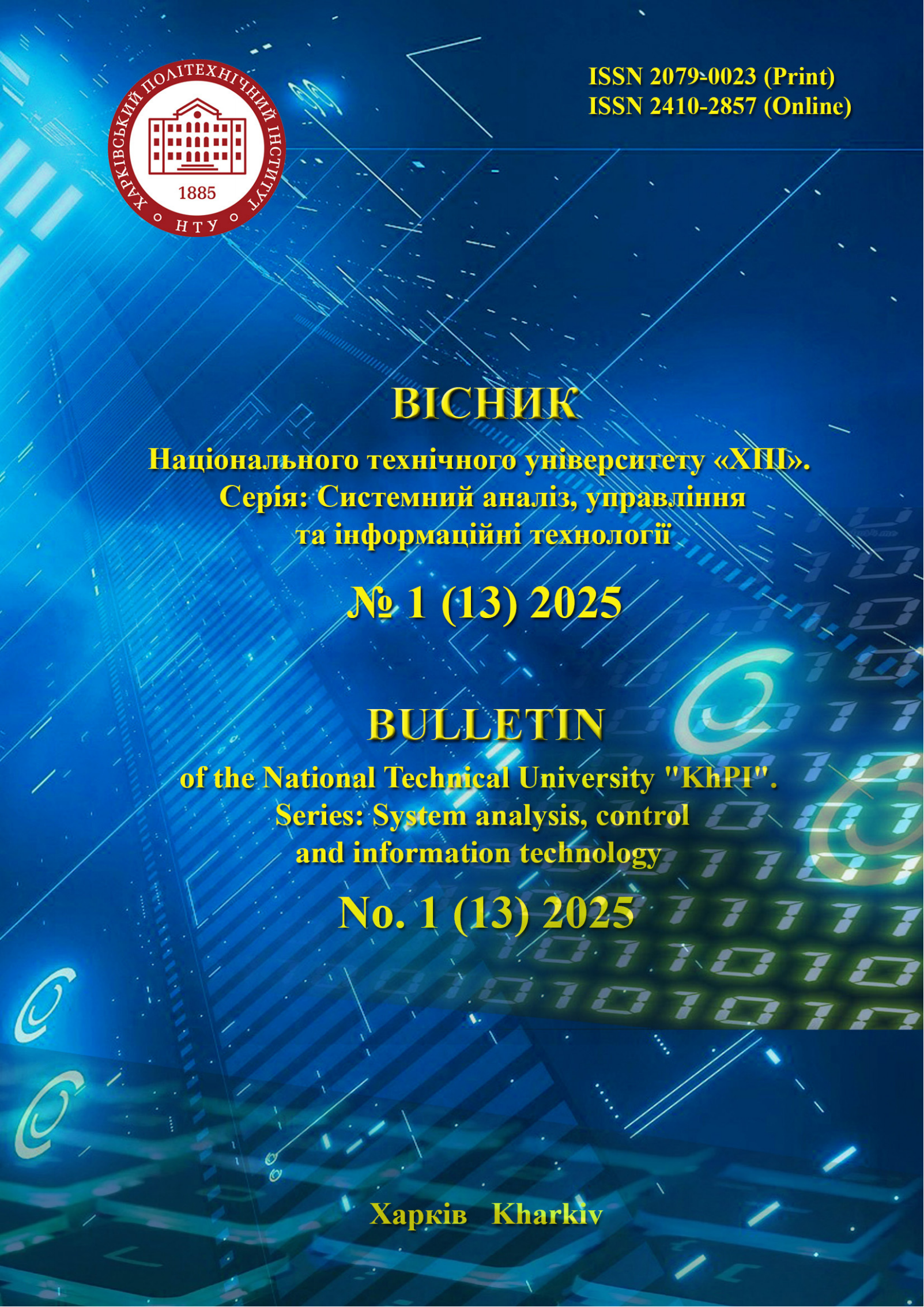STATISTICAL APPROACH TO DETECTION OF ANOMALIES IN WATER DISTRIBUTION NETWORKS
DOI:
https://doi.org/10.20998/2079-0023.2025.01.01Keywords:
water distribution network, anomaly, leakage, simulation modeling, EPANET, statistical hypothesis testingAbstract
This paper is devoted to solving the problem of developing an automated system for detecting anomalies in water distribution networks. The main causes of such anomalies are background leaks and pipe breaks. To address this problem, a statistical approach is proposed, which consists in testing the null hypothesis that the readings of pressure and/or water flow sensors received in real time correspond to the standard conditions of the network. The paper proposes a three-stage anomaly detection scheme, which includes: statistical profiling of network sensors; system calibration to achieve the desired ratio between the risks of false alarms and the omission of existing anomalies; determination of rules for drawing conclusions about the presence of anomalies. A methodology for statistical profiling and calibration of the system based on simulation modeling in the EPANET software environment using the WNTR software interface in Python was developed. In the process of such modeling, the distribution of pressure readings in the network sensors is obtained based on water demand fluctuations. As an example, the model of the L-Town water supply network was studied, which was developed for the BattLeDIM leak detection and isolation competition. The sensitivity of the anomaly detection results to the range of sensor values that are considered normal, as well as the number of sensors involved in the anomaly detection procedure, is investigated. The dependence of the number of sensors with anomalous readings on the size of the leak is analyzed. It is established that there is no combination of parameters of the proposed anomaly detection system that provides optimal results for all possible leakage sizes simultaneously, as a result of which it is proposed to calibrate the system using a man-machine procedure.
References
Liemberger R., Wyatt A. Quantifying the global non-revenue water problem. Water Supply. 2019, vol. 19 (3), pp. 831–837. DOI: 10.2166/ws.2018.129.
Chan T. K., Chin C. S., Zhong X. Review of current technologies and proposed intelligent methodologies for water distributed network leakage detection. IEEE Access. 2018, vol. 6 (12), pp. 78846–78867. DOI: 10.1109/ACCESS.2018.2885444.
Carrasco-Jiménez J. C., Baldaro F., Cucchietti F. Detection of anomalous patterns in water consumption: an overview of approaches. In: Arai K., Kapoor S., Bhatia R. (eds) Intelligent Systems and Applications. Advances in Intelligent Systems and Computing. 2021, vol. 1250. Springer, Cham. DOI: 10.1007/978-3-030-55180-3_2.
Vardhan A. H. et al. Anomaly detection in water distribution systems. 4th Smart Cities Symposium (SCS 2021), Online Conference, Bahrain. 2021, pp. 219–222. DOI: 10.1049/icp.2022.0344.
Gueye K., Boly A., Bame N. Using machine learning for anomaly detection in drinking water from distribution network. 7th International Symposium on Computer Science and Intelligent Control (ISCSIC), Nanjing, China. 2023, pp. 205–210. DOI: 10.1109/ISCSIC60498.2023.00050.
Vrachimis S. G. et al. Battle of the leakage detection and isolation methods. Journal of Water Resourse Plannning and Management. 2022, vol. 148 (12): 04022068, pp. 1–57. DOI: 10.1061/
(ASCE)WR.1943-5452.0001601.
Chandola V., Banerjee A., Kumar V. Anomaly detection: A survey. ACM computing surveys (CSUR). 2009. Vol. 41 (3), pp. 1–58. DOI: 10.1145/1541880.1541882.
Bersimis S., Psarakis S., Panaretos J. Multivariate statistical process control charts: an overview. Quality and Reliability engineering international. 2007, vol. 23 (5), pp. 517–543. DOI: 10.1002/qre.829.
EPANET: Application for modeling drinking water distribution systems. Available at: https://www.epa.gov/water-research/epanet (accessed 10.05.2025).
Liubchyk L. M., Dorofieiev Yu. I. Informatsiini tekhnolohii keruvannia zapasamy v merezhakh postavok : monohrafiia [Information technologies for inventory control in supply networks]. NTU «KhPI». Kharkiv : FOP Panov A. M., 2019. 180 p.
Haktanir T., Ardiclioglu M. Numerical modeling of Darcy-Weisbach friction factor and branching pipes problem. Advances in Engineering Software. 2004, vol. 35 (12), pp. 773–779. DOI: 10.1016/j.advengsoft.2001.07.005.
Travis Q. B., Mays L. Relationship between Hazen-William and Colebrook-White roughness values. Journal of Hydraulic Engineering, 2007, vol. 133 (11), pp. 1270–1273. DOI: 10.1061/(ASCE)0733-9429(2007)133:11(1270).
Todini E., Pilati S. A gradient algorithm for the analysis of pipe networks. In: Coulbeck B., Orr C.-H. (eds) Computer applications in water supply: Vol. 1 - System analysis and simulation. London, John Wiley & Sons, 1988, pp. 1–20.
Klise, K.A. et al. Water Network Tool for Resilience (WNTR) User Manual: Version 0.2.3. U.S. EPA Office of Research and Development, Washington, DC, EPA/600/R-20/185, 2020. 82 p.
Mazmanishvili O. S., Melnykov O. S. Praktykum z matematychnoi statystyky [Workshop on mathematical statistics]. Kharkiv : NTU «KhPI», 2025. 288 p.
Mazzoni F., Marsili V., Alvisi S., Franchini M. Detection and pre-localization of anomalous consumption events in water distribution networks through automated, pressure-based methodology. Water Resources and Industry. 2024, vol. 31, 100255. DOI: 10.1016/j.wri.2024.100255.
Downloads
Published
How to Cite
Issue
Section
License

This work is licensed under a Creative Commons Attribution 4.0 International License.
Authors who publish with this journal agree to the following terms:
- Authors retain copyright and grant the journal right of first publication with the work simultaneously licensed under a Creative Commons Attribution License that allows others to share the work with an acknowledgement of the work's authorship and initial publication in this journal.
- Authors are able to enter into separate, additional contractual arrangements for the non-exclusive distribution of the journal's published version of the work (e.g., post it to an institutional repository or publish it in a book), with an acknowledgement of its initial publication in this journal.
- Authors are permitted and encouraged to post their work online (e.g., in institutional repositories or on their website) prior to and during the submission process, as it can lead to productive exchanges, as well as earlier and greater citation of published work (See The Effect of Open Access).


